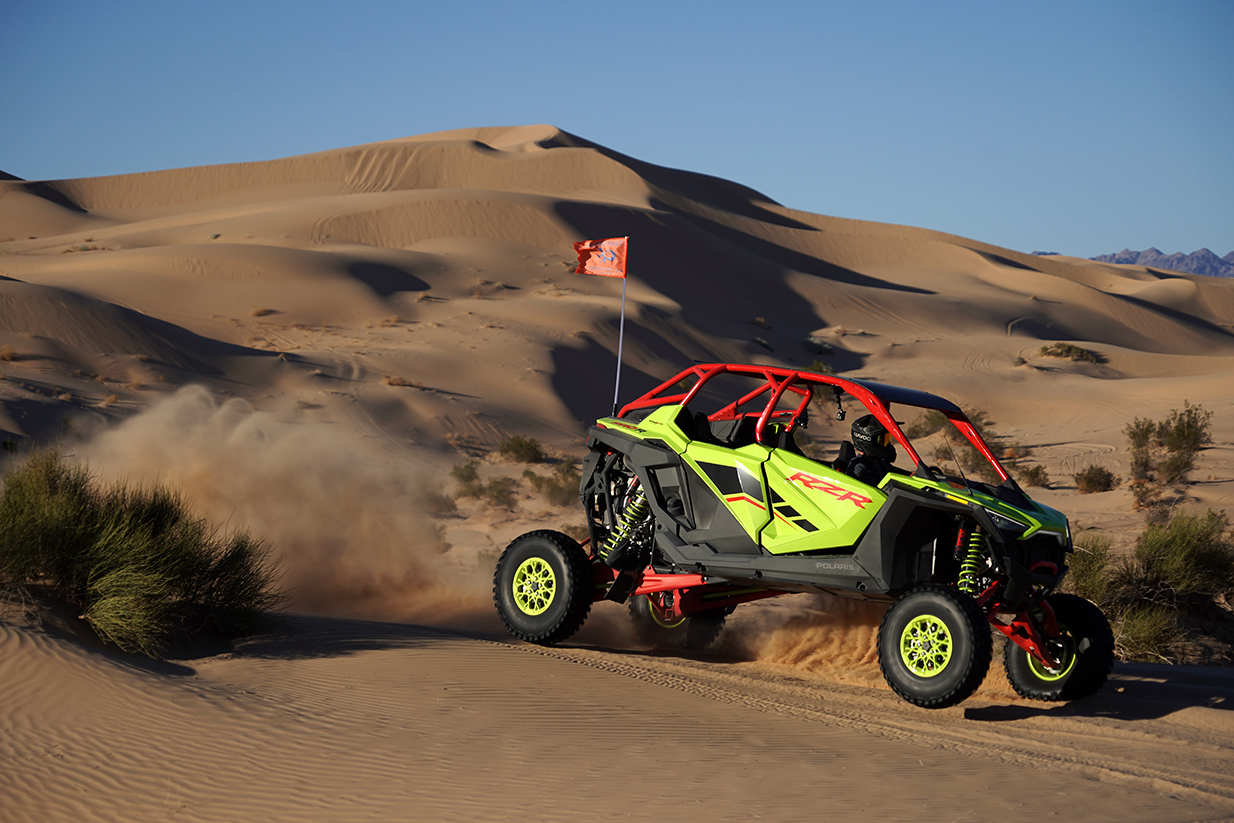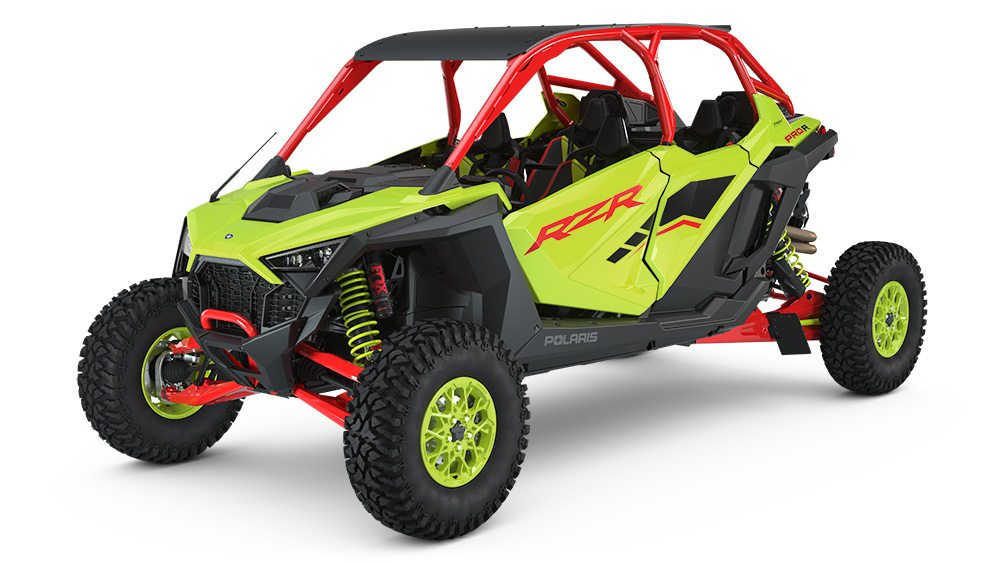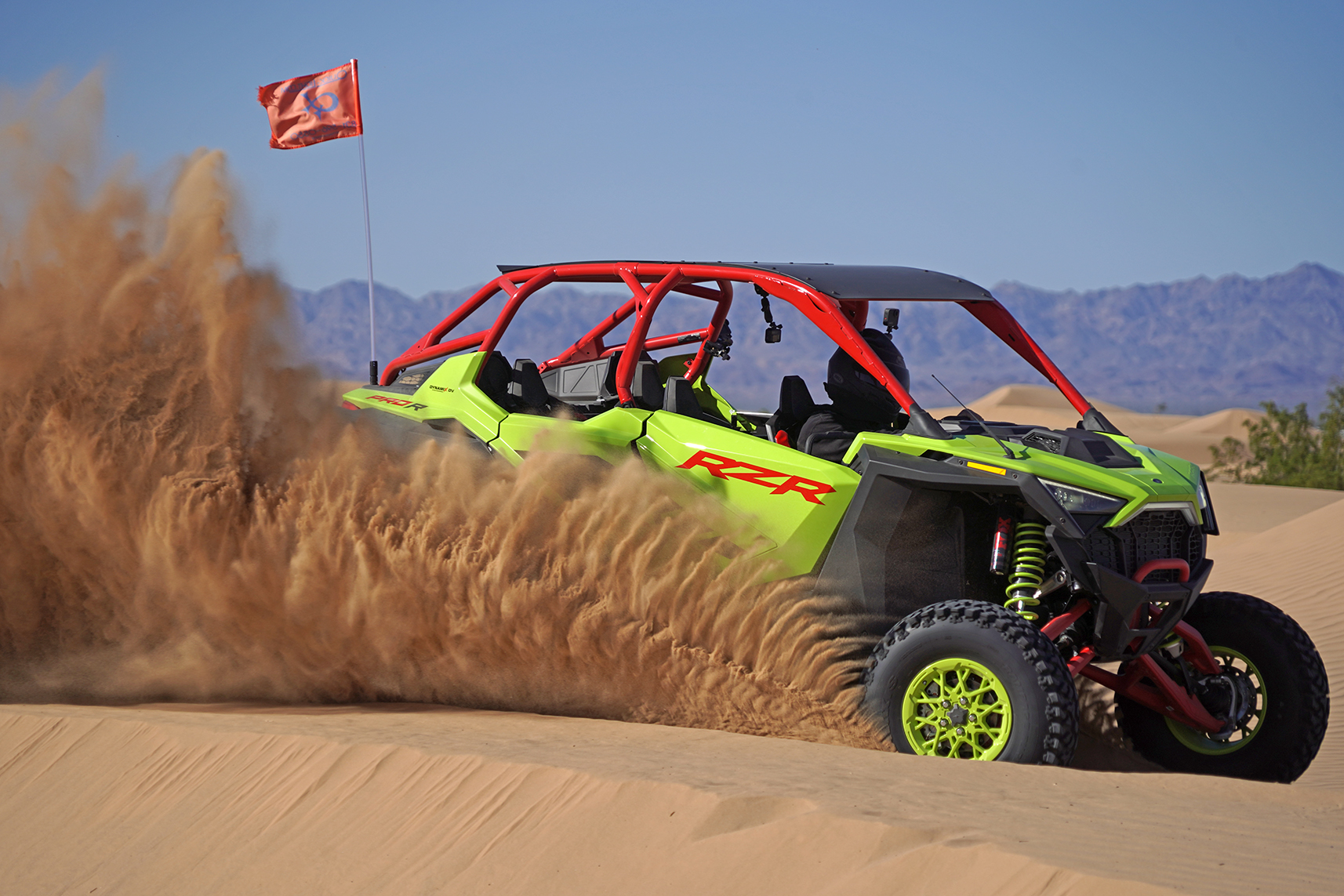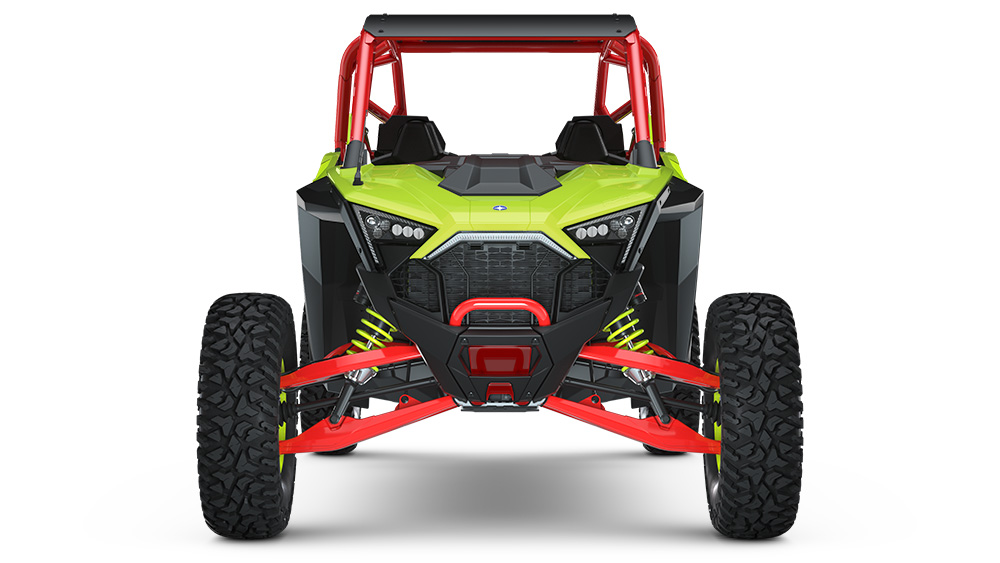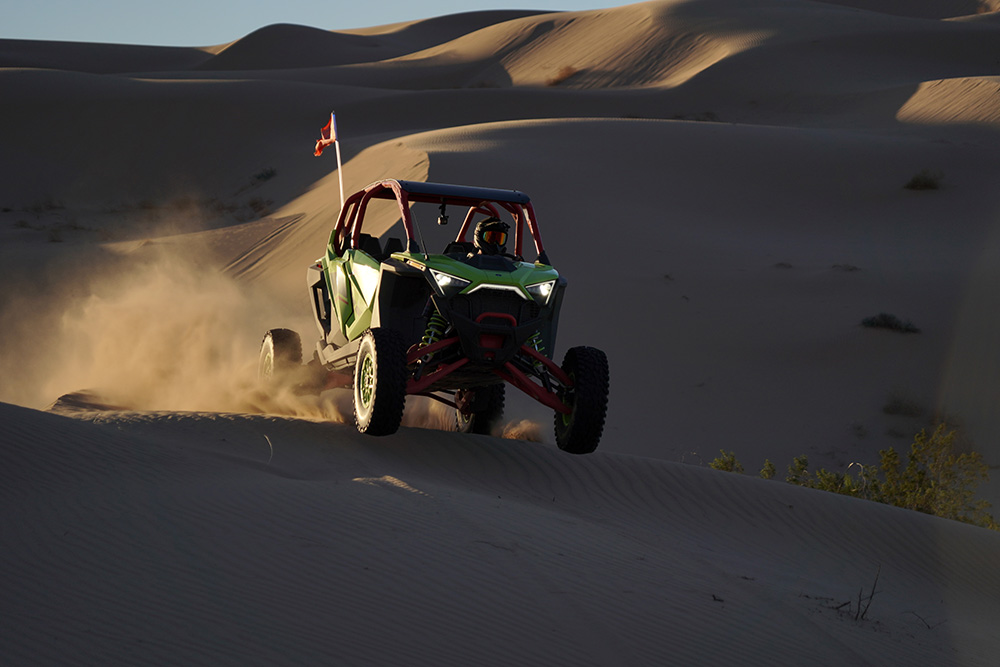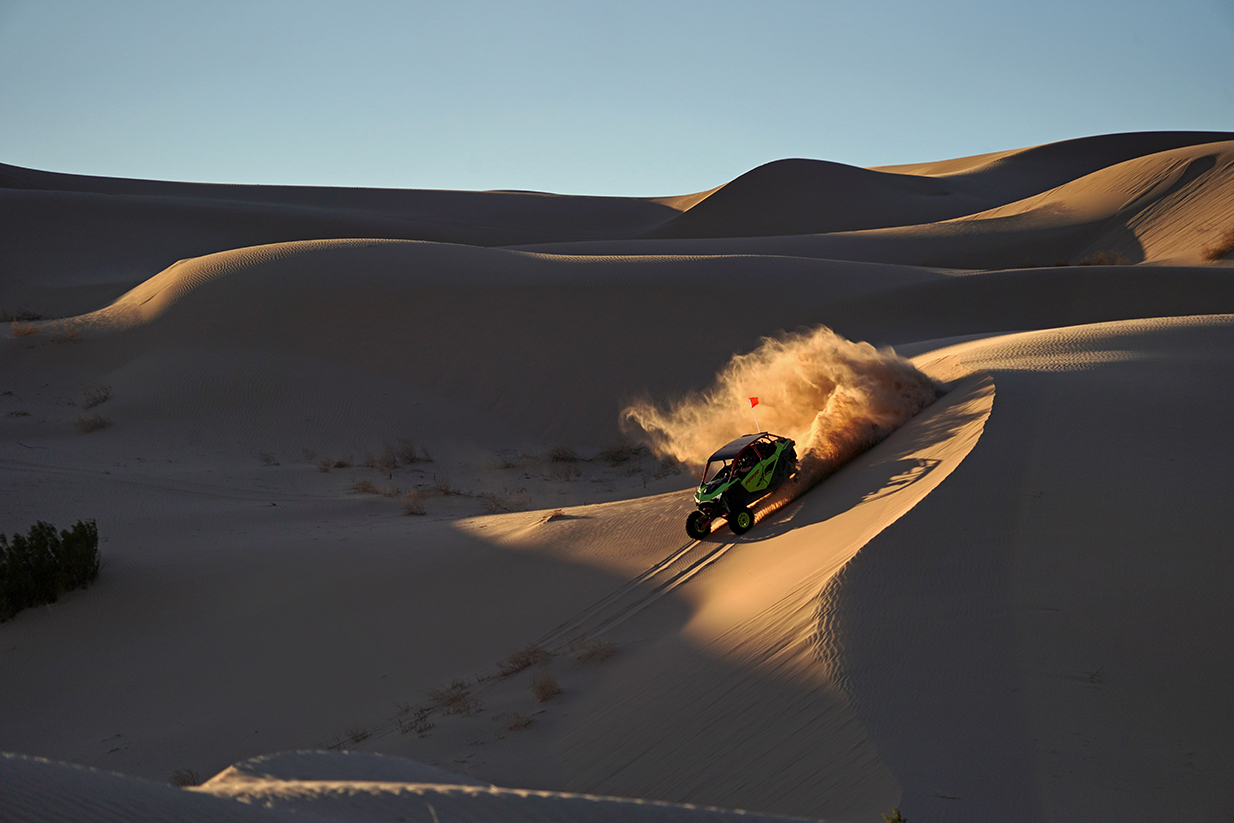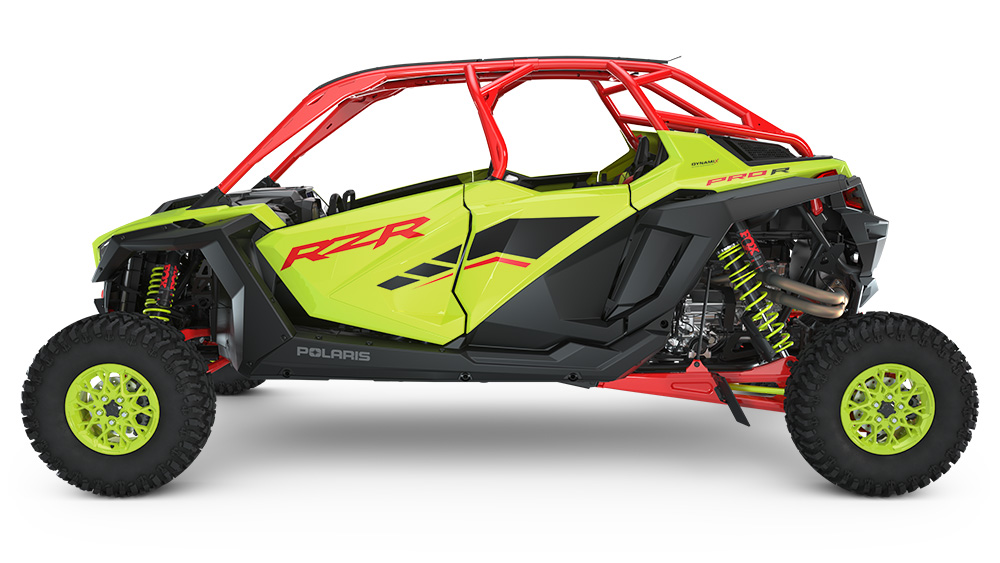Polaris dropped the most hotly-anticipated UTV in recent memory to a very suspecting public just last November, and Pro R units have been sparse on dealer lots recently. A few customers have been lucky or financially inclined enough to get the first round of cars to hit dealers, causing a big spike in prices for any not already sold. The two examples we had on hand for testing came out to around $60,000 out the door – a long way from the Launch Edition’s $44,999 price tag. Big numbers aside, is the Pro R worth the massive hype? Here’s our 2022 Polaris RZR Pro R First Drive Review.
ALSO, SEE: Polaris wins the 2024 Dakar Rally in a Factory Pro R and Shock Therapy Pro R Products
2022 Polaris RZR Pro R First Drive Review
Words: Cody Hooper // Photos: Bradley Howe/Polaris
MSRP: $44,999
Website: www.Polaris.com
2022 Polaris RZR Pro R Highlights:
- Monster engine with incredibly crisp response
- Bottomless suspension travel
- Incredible stability through rough terrain
- Comfortable interior, stock seats and belts hold you in well
- Incredible amount of drivetrain customization
Engine:
The first vehicle from a UTV manufacturer to break the 1.0L invisible wall was Polaris, and they shattered it, stepping all the way up to 1,997cc with the ProStar Fury 2.0 engine in the Pro R. Using a dual overhead cam inline four cylinder engine that was lightened internally and turned up for duty in the RZR program, Polaris delivered a huge leap in UTV development with the introduction of this vehicle. A 62mm contoured throttle body feeds a very large cylinder bore, with 93mm pistons allowing a ton of room for large valves. The Fury’s short-stroke engine provides rapid engine acceleration, making throttle response incredibly quick.
This all adds up to some great numbers: without the help of forced induction, the Fury 2.0 makes 225 horsepower and 152 lb-ft of torque. The Pro R’s engine feel is decidedly different than that of any other UTV currently on the market, and its high-revving four cylinder delivers a great exhaust note.
Transmission/Drivetrain:
Polaris mounted an all-new beefed-up CVT transmission behind the seats, so belt changes now happen inside the cab. Hopefully it won’t need many, as Polaris claims the Pro R uses a wider, longer belt, with larger clutches and improved airflow over previous designs, delivering “the longest belt life ever seen on a RZR”. That claim is reassuring, and we didn’t experience any belt issues during our few days of hard testing in Glamis.
Polaris also outfitted the Pro R with a shock limiter to avoid driveline damage in the event of a sudden stop in wheel speed. They also redesigned the entire driveline, featuring the first divorced RZR engine, transmission, and rear differential to date. CV joints, axle shafts, and knuckles are all much larger than any other RZR past, and 5-lug unitized hubs increase wheel-end durability substantially.
The Pro R also gets another RZR first- a true 4WD system with three selectable modes: 2WD, 4WD with open front differential, and 4WD with locked front differential. These types of 4WD systems are much more confidence-inspiring, as steering feel and power delivery is generally much more consistent than with electronically operated, slip-sensing AWD systems like the RZR typically employs.
Suspension:
Here’s where Polaris engineers dropped another bombshell: the RZR Pro R has the most suspension travel front and rear of any production UTV ever produced. What’s even better is that the engineers were able to create a very clean geometry with the Pro R’s suspension. Polaris engineers used some clever tricks to achieve the Pro R’s massive 22.25” front and 24.5” rear wheel travel numbers. Up front, a forked lower shock mount straddles the axle to allow the engineers to mount the shock to the lower arm, rather than the upper. Why is that a big deal? Mounting to the lower arm stands the shock upright, allowing for a reduction in spring rate and shock stiffness, which in turn keeps the shocks cooler and the ride smoother. It also means that Polaris can fit those massive 3.0-inch body shocks under the hood, without compromising sight lines.
Out back, Polaris got funky with the design again. A three-link trailing arm setup is standard RZR fare, but the center toe link running through the trailing arm to the rear knuckle is not. Polaris designed this toe link to keep the rear tires true throughout their travel, dramatically increasing straight-line stability and cutting out bump steer almost entirely. Three-piece race-inspired sway bars are much more robust than previous designs found in the RZR line. The Pro R also features another industry first: a rack-mounted electronic power steering unit. This frees up quite a bit of space under the dash and helps lower the car’s center of gravity a bit.
Polaris offers the Pro R with Walker Velocity series shocks or the Fox 3.0 Live Valve Dynamix DV setup shown here. The latter is all we have driven, so we will only be speaking about the Dynamix DV-equipped model. Starting with the shocks themselves, the Pro R gets massive Fox internal bypass shocks with 3-inch bodies. Dynamix DV now adjusts compression and rebound damping electronically, whereas previous generations of this technology could only adjust compression. This means that Polaris engineers have great control over wheel speed, allowing them to offer multiple suspension modes. Selectable from the steering wheel, the four modes are Rock, Comfort, Track, and Baja. Pro R Dynamix Models also feature the famous Red “X” button on the wheel, which sends the shocks to full stiffness when pressed in anticipation of a big impact.
Interior:
Here, the Pro R continues to expand the envelope Polaris created when they began transitioning the RZR from the XP chassis to the Pro chassis. The RZR Pro R has much more interior room than an XP, so if you have ever sat in a newer Pro XP, you will be pretty familiar with the interior layout. It features a lot of room for larger drivers, with very comfortable ergonomics and a seating position between a Can-Am X3 and a RZR XP.
The seats and harnesses do a good job of holding occupants in. The seatbelts take a little bit to get used to, as they feature a thigh strap and a belt strap. This does a great job of anchoring your torso, and Polaris fitted retractors to the shoulder straps so you can move a little more freely about the cockpit when you need a little extra reach. They are comfortable, but for those that plan on driving the Pro R hard, a set of 5 point racing belts would offer better movement restriction.
The examples we drove were all outfitted with the Rockford Fosgate stereo and Ride Command dash. The rich feature set Polaris built into the Pro R’s higher trim levels is very high-tech, offering adjustment of many engine and drivetrain settings coupled with industry-leading nav tech and bluetooth audio. What’s not to like?
Seating ergonomics are great, but we do wish the Pro R had a full-round steering wheel as opposed to the flat-bottomed wheel it uses. Tilt and telescoping steering makes the RZR Pro R very easy to fit a driver, and it offers what is perhaps the best seating ergonomics for a driver of any UTV on the market right now. You really feel like you’re tucked down into the Pro R, which lets you concentrate on driving.
Tires/Wheels/Brakes:
Polaris uses a 32-inch Maxxis Rampage Fury 8-ply tire, new to the RZR line. It worked extremely well in the sand at 16 psi, offering great flotation and surprisingly good low-speed turning precision. The Pro R pops up out of the sand extremely easily, thanks to the large 2-liter engine churning out large gobs of smooth torque. Braking power feels equally impressive, with great pedal feel and placement that allows for easy 2-footed driving if that’s your cup of tea. Standard non-beadlock 15 inch aluminum wheels appear on all 2022 Pro R models, but in various colors and two spoke styles.
Competition:
The RZR Pro R’s only close competition is the Can-Am Maverick X3 X RS Turbo RR 72, and optioned to the highest trim level, it is about $10,000 less than the Pro R. That extra ten large gets you a car that is designed a level of performance and durability above the X3, despite what the numbers on the spec chart may tell you. Take a look at both cars side by side and you will see the difference- the sheer size of the components in the suspension, wheel end, frame, and cab cage are very apparent up close. The Pro R to buy would be the Ultimate trim if you want the Dynamix DV, or the Premium model if you want the Walker Velocity shocks. Those cars are $3,000 and $6,000 less expensive than the Launch Edition tested here.
The X3 Max X RS Turbo RR 72 is nearly identical to the Pro R 4 in length and width, coming in a half-inch shorter and 1.3 inches narrower than the RZR. The X3 is a full 6 inches shorter than the Pro R however, and most of that difference can be attributed to ride height and headroom inside the cab cage. Suspension numbers are fairly close, with Can-Am claiming 22 inches of front and rear travel, but in the real world, the RZR Pro R’s useable suspension travel is greater, and its geometry more favorable. We can’t wait to get these two side by side for a direct comparison.
Impressions:
Our first thought when approaching the RZR Pro R 4 for the first time was just how strikingly large it looked. Set to 16 inches of ride height, the Pro R is formidable in size, and requires a lot of real estate on or in the trailer. From the driver’s seat, a ton of adjustability means you can get a really comfortable position fairly quickly, and the Pro R holds you in well while delivering harsh punishment on the desert terrain. The Pro R’s interior is comfortable, and the folding rear seats and decently sized cargo box means you will actually be able to carry cargo with you.
The transmission must be in park to start the engine, and the key only requires a quick bump for the RZR to take over and spin the Fury 2.0 to life. It makes great noises, but the engine’s lively character is the most distinct thing we took away from the driving experience. It responds to throttle inputs with lightning-quick RPM changes, making the big RZR feel light and agile on its feet. The engine has zero problem spinning the hefty 32-inch Maxxis Rampage Fury tires up to speed, offering tire-roasting power reserves at nearly any speed.
ALSO, SEE: ZRP Polaris Pro R Products
Speaking of speed, we saw over 80 miles per hour down the roller whoop section that is Glamis’ sand highway. The owner of the RZR Pro R 4 also remarked that the RZR handles the long whoop sections more comfortably than his high-dollar sand car. Unfortunately, we could’t get them side by side for a comparison video during this test! It goes without saying- please drive at your own comfort level, but the Pro R offers an incredibly high performance envelope for those who do want to push their UTV.
All that power would be a waste without a chassis capable of putting it down, and that’s exactly where the Pro R really shines. The driving experience is well-rounded, with incredible amounts of suspension available to navigate huge bumps. For those who choose to play in desert terrain where big whoops, G-outs and jumps are part of nearly every trail ride, the RZR Pro R offers an incredibly comfortable and capable driver’s car that flaunts next-level driver control in really nasty bumps. Simply put, we don’t think there’s another stock UTV you can drive this hard, this comfortably, with this level of poise. To many, that is well worth the price hike, as this car lives up to the hype.
SPECIFICATIONS: 2022 Polaris RZR Pro R 4 Launch Edition
Engine Size: 1997cc 4-stroke DOHC inline four cylinder
Weight (dry): 2,365 lbs
Length x Width x Height (in): 165.5 x 74 x 76.5
Wheelbase (in): 133.5
Tires: 32 x 10-15 Maxxis Rampage Fury – 8-Ply rated (front/rear)
Wheels: Aluminum, non-beadlock 15×7
Front Suspension: Boxed Dual A-arm with swaybar and 22.25” of wheel travel; Fox 3.0 Live Valve X2 Internal Bypass shocks with Dynamix DV
Rear Suspension: Boxed Trailing Arm with Toe Link, swaybar and 24.5” of wheel travel; Fox 3.0 Live Valve X2 Internal Bypass shocks with Dynamix DV
Fuel Capacity (gal): 12.3
Transmission: Automatic PVT P/R/N/L/H
2WD/4WD: Pro Performance True 2WD/4WD/4WD Lock
| MACHINES: | HIGHEST POSSIBLE SCORE | RZR PRO R 4 |
| ENGINE PERFORMANCE: | 5 | 5 |
| 4WD SYSTEM: | 5 | 5 |
| ENGINE BRAKING: | 5 | 5 |
| TRANSMISSION: | 5 | 5 |
| LOW-SPEED (CRAWLING): | 5 | 5 |
| SUSPENSION: | 5 | 5 |
| HANDLING: | 5 | 5 |
| RIDE COMFORT: | 5 | 5 |
| BRAKING: | 5 | 5 |
| WHEELS & TIRES: | 5 | 4 |
| ERGONOMICS: | 5 | 5 |
| MAINTENANCE: | 5 | 4 |
| INSTRUMENTATION: | 5 | 5 |
| FIT & FINISH: | 5 | 4 |
| OVERALL QUALITY: | 5 | 4 |
| CABIN NOISE: | 5 | 3 |
| CARGO: | 5 | 5 |
| FUEL RANGE: | 5 | 4 |
| PRICE: | 5 | 3 |
| WARRANTY: | 5 | 3 |
| TOTAL OUT OF 100: | 100 | 89 |


